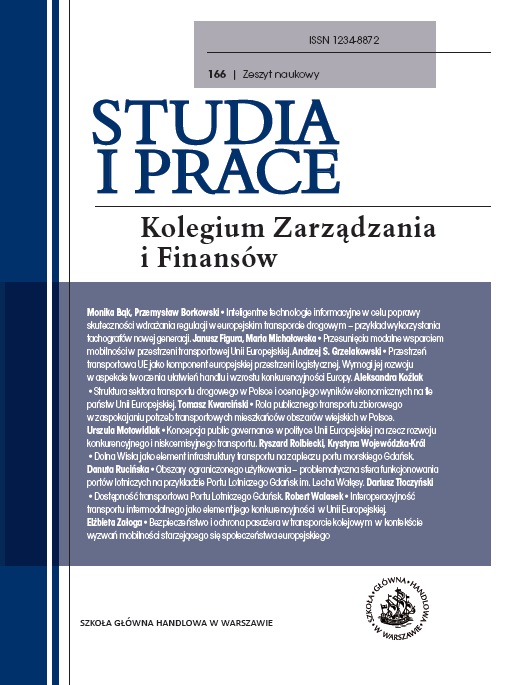Transport Accessibility of Gdansk Airport
DOI:
https://doi.org/10.33119/SIP.2018.166.9Keywords:
transport accessibility, airport links, accessibility, connectivity, Gdansk AirportAbstract
Studies undertaken in the paper assess transport accessibility of an airport. With this objective in mind, three elements have been identified that condition transport accessibility: airport links, accessibility, and connectivity. The paper is centred around the case study of the Gdansk Airport. This airport was selected purposefully since recently it has reported high traffic dynamics, it is situated in the northern part of Poland and acts as a hub for Scandinavian connections, and a base for several air operators. The analysis covered possibilities of reaching the airport that are available to passengers using different connection combinations with the main European hub airports.
As a result of studies we found increasing share of rail transport in servicing the airport. The Gdansk Airport offers good connections with regions, three major directions have been identified. Passengers who travel across the continent select a carrier taking into account multiple factors that impact the service.
Downloads
References
1. Budd, L., Ison, S., Budd T. (2016). Improving the Environmental Performance of Airport Suface Acces in the UK: The rule of public transport. Research Transportation Economics, nr 59.
2. Burghouwt, G., Redoni, R. (2013). Connectivity in Air Transport networks. An Assessment of Models and Applications. Journal of Transport Economics and Policy, Vol. 47, part 1.
3. Dennis, N. (1994). Airline hub operations in Europe. Journal of Transport Geography, No. 2 (4).
4. Dennis, N., Doganis, R. (1989). Lessons in Hubbing. Airline Business, March.
5. Dennis, N. (1994). Scheduling Strategies for Airline hub Operations. Journal of Transport Management, No. 1 (2).
6. El-Geneidy, A. M., Levinson, D. M. (2006). Access to Destinations: Development of Accessibility Measures. University of Minnesota, Minneapolis, May 2006.
7. Geurs, K. T., van Wee, B. (2004). Accessibility Evaluation of Land-use and Transport Stratgies: Review and Research Directions. Journal of Transport Geography, Vol. 12, issue 2.
8. Graham, A. (2003). Managing Airports an International Perspective. Woburn: Butterworth Heinemann.
9. Halpern, N., Graham, A. (2013). Airport Marketing. London New York: Routledge.
10. Jou, R. C., Hensher, D. A., Hsu, T. L. (2017). Airport Ground Access Mode Choice Behaviour after the Introduction of a New Mode: A case study of Taoyuan International Airport
in Taiwan. Transportation Research Part E: Logistic and Transport Review, No. 47 (3).
11. Koźlak, A. (2012). Nowoczesny system transportowy jako czynnik rozwoju regionów w Polsce. Gdańsk: Wydawnictwo UG.
12. Maligetti, P., Paleari, S., Redoni, R. (2007). Connectivity of the European Airport Network: „Self-help Hubbing” and Business Implications, Department of Economics and Technology
Management. University of Bergamo, Working Paper, No. 10.
13. Postorino, M. N., Mantecchini, L. (2016). A Systematic Approach to Assess the Effectiveness of Airport Noise Mitigation Strategies. Journal of Air Transport Management, No. 50.
14. Postorino, M. N., Mantecchini, L. (2014). A Transport Carbon Footprint Methodology to Assess Airport Carbon Emissions. Journal of Air Transport Management, No. 37.
15. Reynolds-Feighan, A., McLay, P. (2006). Accessibility and Attractiveness of European Airports: A Simple Small Community Perspective. Journal of Air Transport Management, No. 12.
16. Shaw, S. (2007). Airline Marketing and Management. Burlington: Ashgate.
17. Spiekermann, K., Wegener, M. (2006). Accessibility and Spatial Development in Europe. Science Regionali, Vol. 5, No. 2.
18. Tłoczyński, D. (2014). Accessibility jako instrument kształtowania polskiego rynku usług transportu lotniczego, w: Polityka ekonomiczna, red. J. Sokołowski, A. Żabiński, Prace Naukowe
Uniwersytetu Ekonomicznego we Wrocławiu nr 348. Wrocław: Wyd. Uniwersytetu Ekonomicznego.
19. Tłoczyński, D. (2016). Konkurencja na polskim rynku usług transportu lotniczego, Gdańsk: Wydawnictwo UG.
20. Tłoczyński, D. (2017). Raport lotniczy 2017. Wiadomości Turystyczne, nr 10.
21. Tłoczyński, D., Wołek, M. (2007). Komplementarność i substytucja w pasażerskim transporcie kolejowym i lotniczym, w: Procesy integracyjne wybranych systemów transportowych,
M. Michałowska (red.). Katowice: Uniwersytet Ekonomiczny w Katowicach.
22. Wensveen, J. G., Air transportation, A Management Perspective. Burlington: Ashgate.
Raporty, opracowania i dane źródłowe
1. Airport Industry. Connectivity, ACI 2014.
2. Dane IATA.
3. Dane PKM.
4. Dane ULC.
5. Department for Transport, Annual Report 2006, CM 6817, Great Britain.
6. Koster, P., Kroes, E., Verhoef, E. T., Travel Time Variability and Airport Accessibility, Tinbergen Institute Discussion Paper, TI 2010–061/3.
Materiały internetowe
1. www.airport.gdansk.pl
2. www.citydriverstaxi.pl
3. www.flightradar24.com
4. www.googlemaps.com
5. www.pkp.com.pl
6. www.ulc.gov.pl
7. www.ztm.gda.pl









